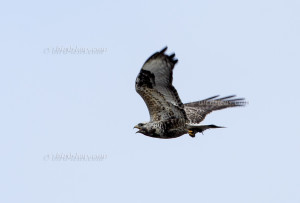 Breeding in the tundra zone of northern Europe, As holarctic guest bird Rough-legged Buzzards (Buteo lagopus) are encountered in Central Europe especially in the winter months. Rough-legged buzzards leave their high northern breeding areas by the end of September / early October. In increasing numbers they migrate in the central European region especially the North German / Polish lowlands a short while late. It is a striking accumulation of north-northeastern sightings observed for this Buteo-Buzzard. For Germany most reports came from North Friesland last year. But Brandenburg counties follow on the step. They are namely Prignitz, Havelland, Dahme-Spreewald and Uckermark.
Breeding in the tundra zone of northern Europe, As holarctic guest bird Rough-legged Buzzards (Buteo lagopus) are encountered in Central Europe especially in the winter months. Rough-legged buzzards leave their high northern breeding areas by the end of September / early October. In increasing numbers they migrate in the central European region especially the North German / Polish lowlands a short while late. It is a striking accumulation of north-northeastern sightings observed for this Buteo-Buzzard. For Germany most reports came from North Friesland last year. But Brandenburg counties follow on the step. They are namely Prignitz, Havelland, Dahme-Spreewald and Uckermark.
During the winter months most Rough-legged Buzzards can be observed by mid-November and then especially in December to mid-February. With nearly 3,000 observations in 2014 (through mid-December) this species is not really rare in Germany. A comparable experience you do observe with the distribution of winter Hen (or Northern) Harrier (Circus cyaneus). Again, you will find an observation distribution, which shows – at least for Brandenburg – that Hen Harriers are practically observed over all suitable areas of fields and meadows in October / November. With 7377 observations, the Harrier is encountered considerably more often but Rough-legged Buzzards.
Good observation areas are wide lowlands – the average altitude level of observations is just at 103 m above sea level (asl). Good observation areas in Brandenburg are, among others the Havelländische Luch between the cities Nauen and Rathenow, the Ungeheuerwiesen (monster meadows) south of Potsdam, the Fiener Bruch neaer Ziesar and the Zauchwitzer Busch. In all these areas, Rough-legged Buzzards can be observed partly from close distance in ongoing hovering flight searching for small vertebrates or resting on a telephone pole. Some observation towers, furnished specifically for nature observation, provide a very good overview. Observation towers can be visited in the Havelländische Luch (built for Great Bustard observations) on the edge to the Ungeheuerwiesen and near the Zauchwitzer Busch. Photographic opportunities are ideal for flying birds. It results in the options to take pictures of the birds from above as well as to take pictures at eye level.
The areas are protected nature conservation areas and have a low intensity of use for the fields and meadows. Most observation areas in Brandenburg mentioned above are characterized by a high level of remoteness of the landscape. They are located in sparsely populated areas which provides the necessary freedom from interference. A varied vegetation structure ensures that not only these raptors will find many different feeding and resting areas. Also for other bird species of open agricultural land these meadows and fields a highly welcome resting and wintering area.
Excursions to the areas near Berlin are always rewarding. During migration it is possible to see thousands of Eurasian Cranes. Besides the species mentioned above, other possible species to be observed from the tower hides are in late fall or winter Eurasian Marsh-Harrier (Circus aeruginosus) and Merlin (Falco columbarius).
There are many airlines which use the Airport of Berlin. An alternative is to take a flight to Frankfurt/ Main, the international hub for Germany, and drive with a rented car in roughly half a day to Berlin and enjoy the landscape while almost flying over the autobahn.
Access to the wintering grounds for raptors are not difficult. There are other places in the nearer surroundings where access is a bit tricky. Please contact via the contact form if I can give further directions or even guide you!